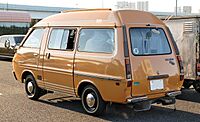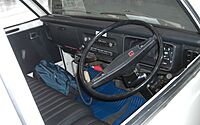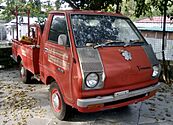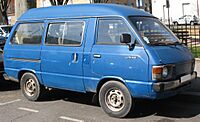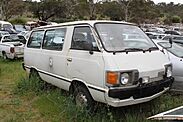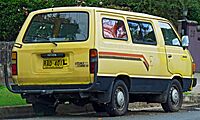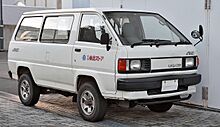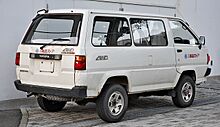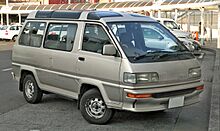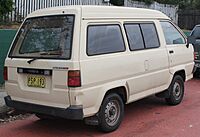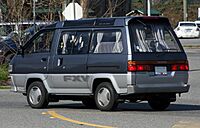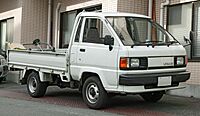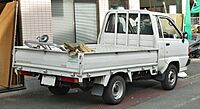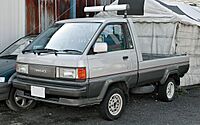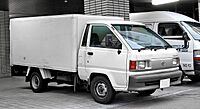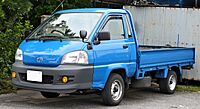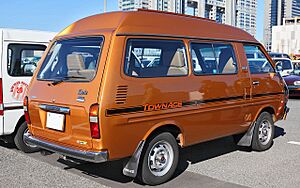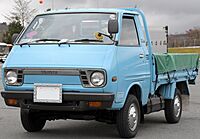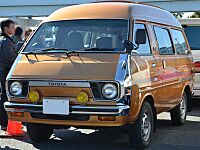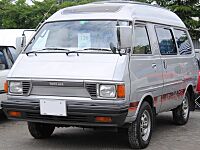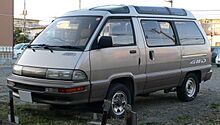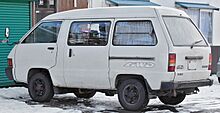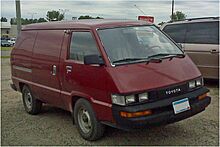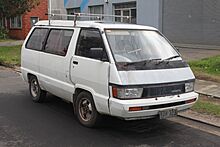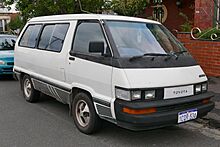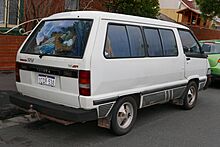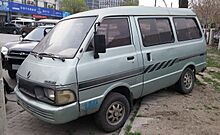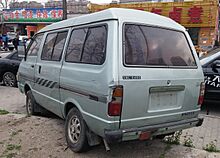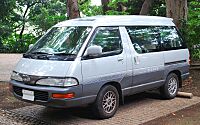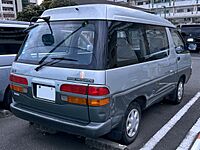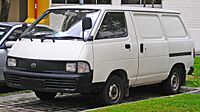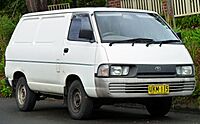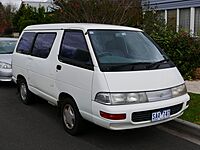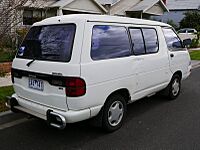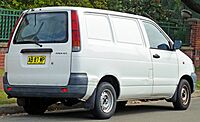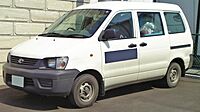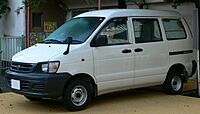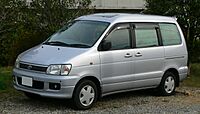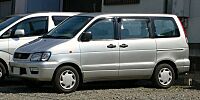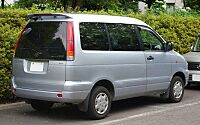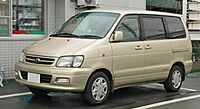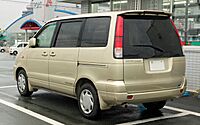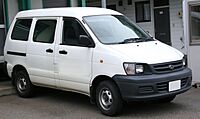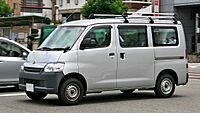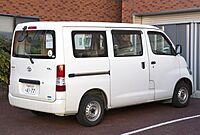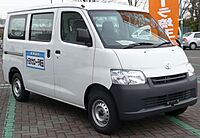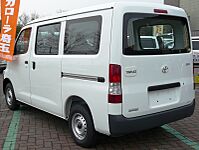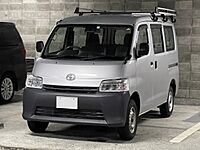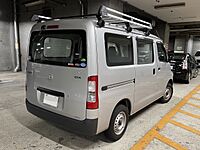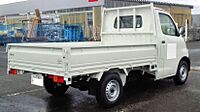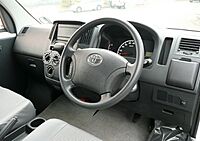Toyota LiteAce facts for kids
Quick facts for kids Toyota LiteAce/TownAce |
|
|---|---|
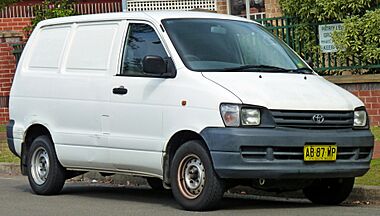
1997–1999 Toyota TownAce (KR42)
|
|
| Overview | |
| Manufacturer | |
| Also called |
|
| Production | 1970–present |
| Body and chassis | |
| Class |
|
| Body style | |
| Layout |
|
The Toyota LiteAce and TownAce are types of vans and pickup trucks made by the Japanese car company Toyota. These vehicles are often used for business, like delivering goods, but they also come as passenger vans.
Originally, these vehicles had a "cab-over-engine" design. This means the driver and front passenger sit right over the engine. Since 1996, they use a "semi-cab-over" design, where the engine is a bit more forward.
The LiteAce first came out in 1970 as a small truck. Vans and passenger versions were added in 1971. In 1976, Toyota launched the TownAce, which was a larger van based on the LiteAce. A TownAce truck followed in 1978. For a while, there was also a fancy passenger van called the MasterAce Surf from 1982 to 1992.
Over time, the LiteAce and TownAce models became more alike. By 1992, the LiteAce vans were even sold as TownAce vans. These vehicles were popular and sold in places like Africa, Asia, and Australia. Some models were also sold by Daihatsu under the name "Delta".
The LiteAce was designed to fit between the smaller MiniAce and the larger HiAce. It was a good size for Japanese rules about car dimensions and engine size, which helped buyers avoid extra taxes. The name "Ace" comes from the Toyota ToyoAce truck. "Lite" means it's a light-duty vehicle, and "Town" suggests it's good for city driving.
Contents
M-series Models
First LiteAce: 1970–1979
| M10 | |
|---|---|
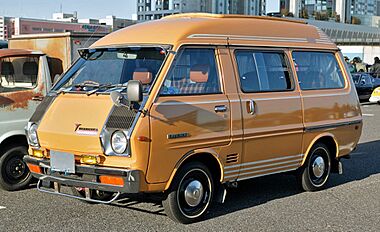
1973–1975 LiteAce wagon (KM10G; pre-facelift)
|
|
| Overview | |
| Also called | Daihatsu Delta 750 (D10) |
| Production | November 1970 – September 1979 |
| Assembly |
|
| Body and chassis | |
| Body style |
|
| Layout | Front-engine, rear-wheel-drive |
| Related | Toyota TownAce (R10) |
| Powertrain | |
| Engine |
|
| Transmission | 4-speed manual |
| Dimensions | |
| Wheelbase | 2,050 mm (80.7 in) |
| Length |
|
| Width |
|
| Height |
|
| Weight |
|
| Chronology | |
| Predecessor | Hino Commerce |
The first LiteAce truck, called the M10, came out in November 1970. It was designed to be bigger than the MiniAce but smaller than the HiAce. This size helped it fit Japanese rules for vehicle size and engine power.
The LiteAce truck could carry up to 750 kg (about 1,650 pounds). It had a front bench seat for three people. You could choose a high or low cargo bed.
In February 1971, Toyota released a van/wagon version of the LiteAce. It first had only one sliding door on the passenger side. You could get it with three, six, or nine seats. In 1973, a five-door version with two sliding doors became available, along with a high-roof model.
The front of the LiteAce had vertical black grilles above the headlights. The van had a back door that opened upwards.
The LiteAce used a 1166 cc engine at first. In 1978, it got a slightly larger 1290 cc engine. At the same time, the front of the car was updated with new panels and badges.
- Daihatsu Delta 750: This truck was also sold by Daihatsu as the Delta 750 starting in 1971. It was very similar to the LiteAce truck, with small changes to the front grille.
Second LiteAce: 1979–1985
| M20 | |
|---|---|
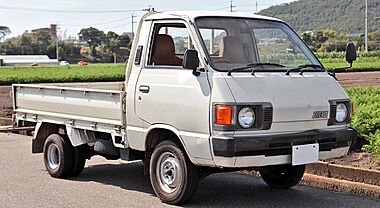
1982–1986 LiteAce truck "just low" (KM20; facelift)
|
|
| Overview | |
| Also called | Daihatsu Delta 750 (D20) |
| Production |
|
| Assembly | Japan: Toyota, Aichi (Honsha plant; October 1979 – September 1982) |
| Body and chassis | |
| Body style |
|
| Layout | Front-engine, rear-wheel-drive |
| Powertrain | |
| Engine | |
| Transmission |
|
| Dimensions | |
| Wheelbase | 2,080 mm (81.9 in) |
| Length |
|
| Width |
|
| Height |
|
| Weight |
|
The second LiteAce vans, wagons, and trucks came out in Japan in October 1979. These models were sold in many countries for the first time. The wagon could seat up to eight people.
New features included optional dual air conditioners and a four-speaker sound system. Some high-roof wagons even had a moonroof. Truck versions had a "just low" model. This meant the rear wheels were smaller (10 inches) to make the cargo bed lower.
At first, the van and truck used a 1290 cc engine. The wagon got a more powerful 1770 cc engine. In 1980, the wagon also got options for an automatic or five-speed manual transmission. A special "handy-cab" version was made for passengers using wheelchairs.
In 1982, the LiteAce M20 series got a small update. This included a new front look and power steering. The van and wagon also got new engine options, including a diesel engine.
When the new TownAce van came out in 1982, the M20 LiteAce truck became the basis for the new TownAce truck. The LiteAce van continued until 1985, and the truck until 1986.
- Daihatsu Delta 750: Like the first generation, the M20 LiteAce truck was also sold as the Daihatsu Delta 750.
Third LiteAce: 1985–2007
| M30, M40, M50, M60, M70, M80 | |
|---|---|
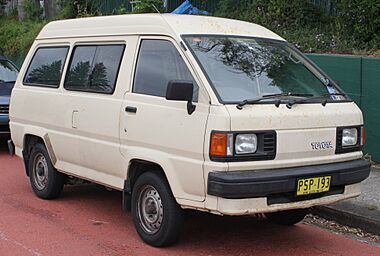
LiteAce van (YM30)
|
|
| Overview | |
| Production |
|
| Assembly | Japan: Toyota, Aichi (Honsha plant, 1985–2004); Hamura, Tokyo (Hino, 2004–2007) Philippines: Parañaque (TMP, 1989–1999) |
| Body and chassis | |
| Body style |
|
| Layout |
|
| Powertrain | |
| Engine | |
| Transmission |
|
| Dimensions | |
| Wheelbase |
|
| Length |
|
| Width |
|
| Height |
|
| Weight |
|
The third LiteAce van and wagon (M30/M40 series) came out in September 1985. They offered four different roof styles. The body became wider but a bit shorter. The rear suspension was improved for a smoother ride. The steering also became easier to use.
The inside was designed so the driver felt like they were in a regular car. The wagon could seat five or six people, with optional third-row seats that could fold sideways for more luggage room. Some versions had seats that could turn to face different directions.
The engine was located under the front seat, but it was a bit hard to reach for repairs. These vans and wagons used different gasoline and diesel engines. In 1985, a four-wheel drive option was added.
Truck versions of the LiteAce and TownAce (M50/M60/M70/M80) were released in October 1986. They used gasoline or diesel engines.
In 1988, the van and wagon got a new look for the front and back, making them slightly longer. This update was only for Japan. Some models also got a special electronic suspension system. In 1989, a five-door version with two sliding doors became available.
Even though new vans and wagons came out in 1992, the M-series trucks continued to be made until 2007. The trucks got a new front design in 1996. In 1999, the trucks were updated again with a new front and dashboard. They also got standard anti-lock brakes and optional airbags. The four-wheel drive system became full-time.
R-series Models
First TownAce: 1976–1982
| R10 | |
|---|---|
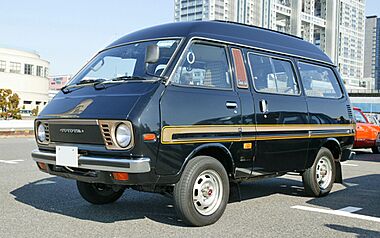
1978 TownAce wagon Custom Extra (TR15; pre-facelift)
|
|
| Overview | |
| Also called | Daihatsu Delta Wide (B10) |
| Production |
|
| Assembly | Japan: Toyota, Aichi (Honsha plant) |
| Body and chassis | |
| Body style |
|
| Layout | Front-engine, rear-wheel-drive |
| Related | Toyota LiteAce (M10) |
| Powertrain | |
| Engine | |
| Transmission |
|
| Dimensions | |
| Wheelbase |
|
| Length |
|
| Width |
|
| Height |
|
| Weight |
|
The first TownAce (R10 series) was launched in October 1976. It was a wider and longer version of the LiteAce M10, but used some of the same parts. The TownAce was positioned between the LiteAce and the larger HiAce.
At first, it was offered as a three- or six-seater van. The eight-seater wagon had seats that could fold completely flat. The third-row seats could also fold to the side to make more space for luggage.
Truck versions were added in October 1978. They included low-deck, high-deck, and "just low" models. The "just low" trucks had smaller rear tires to lower the cargo bed.
In December 1980, the TownAce got a small update. It featured rectangular headlights and plastic bumpers. It also offered an optional cool box and an electric moonroof. The wagon range expanded, offering automatic and five-speed manual transmissions. Some second-row seats could even slide and turn to face forward or backward.
When this generation was replaced in November 1982, the TownAce van and truck lines split. The new van was based on the R20/R30 series, while the truck became a rebadged LiteAce M20.
- Daihatsu Delta Wide: The TownAce was also sold by Daihatsu as the Delta Wide (B10 series) from 1976 to 1982.
Second TownAce & MasterAce Surf: 1982–1991
| R20, R30 | |
|---|---|
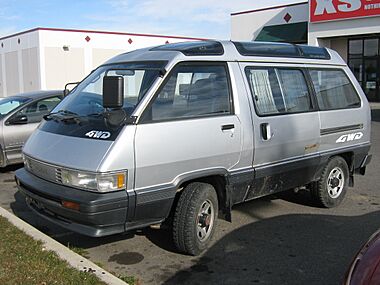
1985–1988 TownAce (first facelift)
|
|
| Overview | |
| Also called |
|
| Production | November 1982 – December 1991 |
| Assembly | Japan: Kariya, Aichi (Toyota Industries HQ Kariya Plant) |
| Body and chassis | |
| Body style | 4-door van/wagon |
| Layout |
|
| Powertrain | |
| Engine | |
| Transmission |
|
| Dimensions | |
| Wheelbase | 2,235 mm (88.0 in) |
| Length | 4,315–4,455 mm (169.9–175.4 in) |
| Width | 1,670–1,685 mm (65.7–66.3 in) |
| Height | 1,940–1,955 mm (76.4–77.0 in) (high roof) |
| Chronology | |
| Successor | Toyota Previa/Estima (for MasterAce) |
The second TownAce van and wagon came out in November 1982. At the same time, Toyota released the MasterAce Surf, a more luxurious version. Both were very similar mechanically. The TownAce had a "front mid-engine" design, meaning the engine was under the front seats. Four-wheel drive became an option in 1985. Many parts of the car, like the suspension, were based on the Toyota Hilux truck.
The R20/R30 models had a sloped front design. You could choose from three roof heights. The two taller roofs had an optional dual moonroof. The MasterAce Surf also offered these roof and moonroof options. The MasterAce Surf looked a bit different with larger bumpers and rectangular headlights.
In Japan, these vans had many cool accessories. These included a refrigerator with an ice maker, a seven-speaker sound system, and even a color television. A "Catalina" package for the MasterAce Surf included removable loft beds.
Toyota updated the TownAce and MasterAce Surf in August 1985, changing the headlights and tail-lights. Another big update happened in August 1988, which included a new interior.
At first, they used an 1812 cc gasoline engine. Later, other gasoline and diesel engines became available. In 1984, a turbocharged diesel engine was introduced. Four-wheel drive models were added in 1985.
Toyota released the larger Estima in 1990. This new model replaced the TownAce and MasterAce Surf in many countries. However, in Japan, the R20/R30 models continued until 1992. This was because the Estima was too big for Japan's "number five" tax category. Toyota later released smaller versions of the Estima in Japan to fit these rules.
- Daihatsu Delta Wide: Daihatsu also sold van/wagon versions of the TownAce as the Delta Wide (B20 series).
- Export Models: Toyota sold the R20/R30 model around the world under different names. In North America, it was called the "Toyota Van." In Australia, it was the Toyota Tarago. In parts of Europe, it was known as the "Toyota Space Cruiser" or "Toyota Model F."
In North America, the "Toyota Van" was sold from 1983. It had styling similar to the MasterAce Surf. It came with different engines over the years. Four-wheel drive models were sold from 1987 to 1989. These models had skid plates for off-road driving.
The "Toyota Van" offered features like dual air conditioning, captain's chairs, twin sunroofs, and power windows.
For Australia, the Tarago eight-seater launched in 1983. It had a front look similar to the TownAce. It came with different gasoline and diesel engines. Over the years, it received updates and new features like power steering, air-conditioning, and cruise control.
In China, a company called Golden Dragon made a licensed version of the TownAce called the XML6390.
Updated R-series: 1992–1996
| R20, R30 rebodied | |
|---|---|
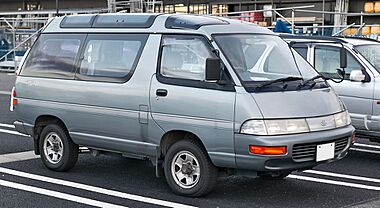
1993–1996 TownAce wagon 4WD Super Extra (CR31G)
|
|
| Overview | |
| Also called |
|
| Production | January 1992 – September 1996 |
| Assembly | Japan: Kariya, Aichi |
| Body and chassis | |
| Body style | 4-door van/wagon |
| Layout |
|
| Powertrain | |
| Engine | |
| Transmission |
|
| Dimensions | |
| Wheelbase | 2,235 mm (88.0 in) |
| Length | 4,360 mm (171.7 in) (van) |
| Width | 1,690 mm (66.5 in) (van) |
| Height | 1,800 mm (70.9 in) (van) |
| Weight | 3,284.89 lb (1,490 kg) |
This updated R20/R30 series was launched in January 1992. The main parts of the car stayed the same, but the outside look was completely new. From this point, the LiteAce van and TownAce van shared the same body design. This meant all LiteAce and TownAce models (vans and trucks) were now unified.
The new design was much smoother. The LiteAce and TownAce commercial vans looked very similar. The TownAce had extra headlights next to the main ones and a small air vent. The LiteAce had different grilles where those extra lights would be. The passenger wagons of both models had unique styling too.
Toyota Australia released the TownAce commercial van in 1992. The eight-seater passenger wagon, called the Toyota Spacia, arrived in 1993. These models had a 2.2-liter engine with a five-speed manual or four-speed automatic transmission. They came with basic features like power steering and a radio.
- Daihatsu Delta Wide: Daihatsu continued to sell versions of the TownAce van/wagon as the Delta Wide. These were simply rebadged TownAce models.
Modern R-series: 1996–2007
| R40, R50 | |
|---|---|
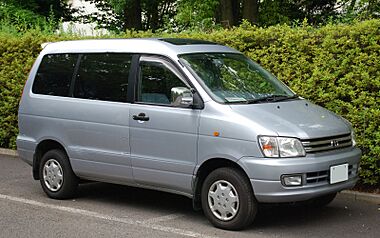
1996–1998 TownAce Noah
|
|
| Overview | |
| Also called |
|
| Production | October 1996 – July 2007 |
| Assembly |
|
| Body and chassis | |
| Body style | 4/5-door van/wagon |
| Layout |
|
| Powertrain | |
| Engine | |
| Transmission |
|
| Dimensions | |
| Wheelbase | 2,715 mm (106.9 in) |
| Length | 4,435 mm (174.6 in) |
| Width | 1,695 mm (66.7 in) |
| Height |
|
| Weight | 1,420–1,440 kg (3,130–3,170 lb) |
| Chronology | |
| Successor | Toyota Noah (for LiteAce/TownAce Noah) |
The R40 and R50 LiteAce and TownAce models were completely redesigned and launched in October 1996. They were only offered as vans or wagons. The wagons were now called LiteAce Noah and TownAce Noah, and they had a more luxurious interior. The LiteAce and TownAce vans were different mainly by their front grille designs.
For better safety, the engine was moved from directly under the driver to in front of the passenger area. This gave the cars a new look. Even though many competitors switched to front-wheel drive, these models kept their rear-wheel drive. Full-time four-wheel drive was an option.
The Noah passenger models had three rows of seats. They could seat six, seven, or eight people. The flat floor made it easy to walk between the rows.
Vans came with several gasoline and diesel engines. The Noah models had a gasoline engine or a turbocharged diesel engine. You could choose a five-speed manual or a four-speed automatic transmission.
In 1998, the Noah models were updated with new headlights, grilles, and bumpers. Vans were updated in 1999. In 2001, the LiteAce Noah and TownAce Noah models were replaced by the new Toyota Noah and Voxy. Diesel engines were stopped in 2004 because of new emissions rules. The vans got another update in 2005.
- Export Models: Toyota Australia sold the TownAce commercial vans from 1997 to 2003. The eight-seater passenger vans were sold as the Spacia from 1998 to 2002. The Spacia came with standard airbags, power locks, power steering, windows, and mirrors.
- Daihatsu Delta Van/Wagon: This generation was also sold as the Daihatsu Delta Van/Wagon. Their grilles looked like the TownAce models.
S-series Models
Current TownAce/LiteAce: 2008–Present
The newest S400 series of LiteAce and TownAce vans and trucks came out in Japan in February 2008. These models are now "badge engineered." This means they are actually Daihatsu Gran Max vehicles made in Indonesia, but sold as Toyotas.
They still have a semi-cab-over design, with the engine under the front seats. The van only comes with a standard roof. The truck has a high cargo bed. These models use a 1,495 cc engine. You can choose a five-speed manual or a four-speed automatic transmission. Rear-wheel drive is standard, and full-time four-wheel drive became an option in 2010.
In June 2020, the LiteAce name was stopped in Japan. All models are now sold under the TownAce name. The TownAce also got a new 1,496 cc engine and a new look. The pickup truck version has been sold in Taiwan since 2021 and in the Philippines since 2022.
See also
- List of Toyota vehicles


